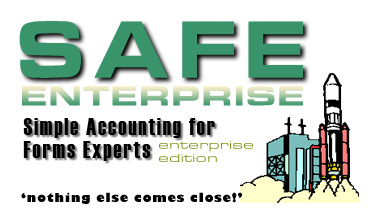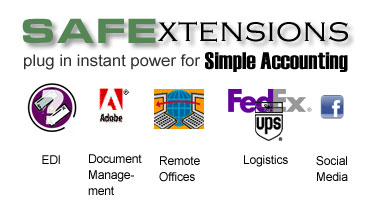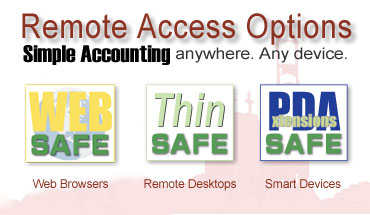Using Simple Accounting on a network can increase your company’s productivity immensely. Virtually all the functions you use each day to get transactions in and then get information back out can be done simultaneously by many users. If you are already using Simple Accounting in a single-user environment, you’ll be glad to know that the software operates almost identically in multi-user mode as it does in single-user mode. So lets reiterate: Simple Accounting is Multi-User! There aren’t separate versions of the software for use in single-user or multi-user environments. When you license the software, you do so in multi-user mode, so you can begin sharing your existing data on your network almost immediately.
This section gives you the information necessary to use Simple Accounting on your network with the following topics:
- Hardware requirements
- Configuring your network
- The few operational differences between Single-User and Multi-User modes
Also, since networking principals are not well understood by many users, we also discuss some basic networking principals, dos-and-don’ts, and tips for improving network performance.
Network Basics
Simple Accounting software functions like many shared applications: The software and data files are installed in a shared directory on a single computer designated as the server. A server is a computer that shares its resources with other computers on the network. These resources may include such devices as disk drives, printers and modems, depending on how your network is configured. Other users’ machines are called clients. Each client’s machine name is known to Simple Accounting to help identify who is doing what at any given time.
When attached or logged onto the network, client machines behave as if they are connected directly to the server’s disk drives and printers. The network software redirects each client’s printing and file requests to the server’s printers and disk drives across the network cable. It does this by making each client appear to have additional logical printer ports (LPT’s) and logical drives which actually access the physical printer ports and disk drives on the server. So for example, the client’s LPT3 may actually print to LPT1 on the server. Likewise, the client H: drive may actually access the C:SIMPLE directory on the server.
When using Simple Accounting, clients will all be executing a single copy of the software. Each client switches to the server drive to start the program, which loads the software into each client’s RAM for execution. This is important because although each client has access to the server’s disk drives and printers, they are still executing programs on their own machines. So, although the server may be faster than the client machines, each client’s copy of Simple Accounting cannot run faster than their machine will allow. In other words, just because you installed a Dual-Pentium super server to run Simple Accounting, don’t expect your ‘486 workstations to suddenly run like never before!
In fact, a speedy server can increase the apparent speed of certain networked applications like Simple Accounting, but for the most part, the strain on the server from supporting several users simultaneously usually results in a minor decrease in speed over using the software in single-user mode. Minimizing this decrease is covered in the sections on optimization that follow.
SEEKING PROFESSIONAL HELP
By the way, we’re not trying to be confusing when discussing performance. It’s just that it can be a real challenge squeezing the last bit of performance out of any network. To sum it up, there is no trick to running Simple Accounting on a network, however, getting the best possible performance may take some doing.
We suggest seeking help from a qualified network specialist, before buying your network. They can help you plan to accommodate future growth, ensure reliability, and optimize performance. How do you find a network specialist? Well, first of all there’s us: We can provide you with everything you need to get started, including hardware, software, and good advice.
But if you want someone a bit closer to home, you’ll need to find someone in your area. What to look for? The same things you would look for in any professional (good network guys really are professionals). Check out their staff, number of clients, years in business, and get references, references, references.
Important: Ask for certified qualifications! For Microsoft, this means a Microsoft Certified Systems Engineer (MCSE). For Novell, it means a company with at least one Certified Netware Engineer (CNE) on staff. For LANtastic, this means an authorized 5-Star dealer. And for all dealers, there is also the Local Area Network Dealer Association (LANDA), which provides independent certification for professionals around the country.
SUPPORTED NETWORKS
Simple Accounting has been used successfully on many types of PC networks. Since the system uses only standard, documented Microsoft-approved network programming, it should function well on almost any popular network. However, our in-house testing has been limited to three major vendors, so we provide product-specific support for only the following:
PRODUCT VENDOR VERSIONS
LANtastic Artisoft Version 7.0 and above
Microsoft Microsoft (included with Windows95/98 and NT)
NT Microsoft Version 3.51 and above
Netware Novell Version 3.11 and above
Installation
Installing Simple Accounting On Your Server
The first thing to do is to install the system on your server. You do this by installing Simple Accounting exactly as you would for a single-user installation. The only difference is that the destination folder will refer to a network server drive. If you use a peer to peer network without a dedicated server you can install on the workstation which is doing double-duty as a server. Otherwise, youll be installing from a workstation to the dedicated server.
If you are using Windows95 or 98s built-in networking, make certain that you have file sharing enabled on the server. (If you do not, you would not see the server computers folder in the Network Neighborhood.)
Setting Up Other Workstations
Once the software is installed on the server and the first workstation you will need to set up other workstations. Do this as follows:
1. Go to the workstation and make certain that the workstation is logged into the server to which Simple Accounting has been installed.
2. Super Important: If you are using the built-in Windows Networking, make certain that the drive you are connected to is mapped to a drive letter. If it is not mapped, the workstation will create empty data files on its own drive and will not connect with your servers data.
3. Start Find from the Taskbar. Select Files and Folders
4. Type Simple Accounting in the Named field and select the My Computer icon in the Look In field. Also, make certain the Search Subfolders box is checked. When youve done these three things, press the [Find Now] button.
5. After a few seconds, you should see the Simple Accounting folder from the network server in the browse below.
6. Double click on the Simple Accounting folder. You will now see the contents of this folder. Scroll down the SAFE EE item (SAFE.EXE) and select that item.
7. While holding down the Shift key, drag the SAFE EE icon onto the Desktop. This creates adrop-down-list to the servers copy of SAFE EE.
Now the user can access the Simple Accounting from his or her desktop. Simply repeat these steps for each user.
Management Issues
It is important to recognize that networks are, like marriage, a process, not a thing. They require ongoing attention in order to work well.
MANAGING ACCESS
It is very important that Simple Accounting prevent users from performing certain tasks which change data at the same time. This doesn’t mean that multiple users cannot use the Simple Accounting simultaneously. But certain operations must be limited in order to protect the integrity of your data and the accuracy of the information.
These limitations are dubbed file and record locks. A file lock limits one user to modifying any data in that file. A record lock prevents more than one user from modifying a single record in that file; other users can still, however, change other records in that file. To clarify the need for locks, consider the following examples, which show what would happen if there wasn’t any locking system:
- You want to run a list of customers statements, while your associate is attempting to update addresses for all customers. Before starting your report, your customer SMITH BROS shows an address of 123 Main Street, Verona, MI 48921. But the U.S. Postal Service has changed all zip codes from 48921 to 48994, so your associate is dutifully updating your customer file as you print your statements. Your statements prints some customer addresses correctly, but some, like SMITH BROS, are printed with the old address before the associate has finished updating the records. So the SMITH BROS statement is mailed to the wrong address…
- You are editing an order for SMITH BROS. You’ve added a couple of new Line Items, but you still need to change some critical delivery notes on one other item. You stop, at that point, to look up something in the filing cabinet, leaving the unfinished order on your screen. At the same time, your associate decides to print the order and ship the product. Whoops…
The first example shows the need for a file lock: The entire customer file must be prevented from being changed while the statements are printing, otherwise some may be inaccurate.
The second example shows the need for a record lock: The order on which you are working must be prevented from being changed until you say it’s done.
MINIMIZING DELAYS
These limitations are not as inconvenient for users as they might at first seem for the following reasons: First of all, locks generally apply only to writing (i.e. adding, changing, or deleting) records. There are fewer limitations on simultaneous reads. This means that two users can view, or print the same records, at the same time, so long as neither is attempting to change those records.
Second, most locks last for only a short while. For example, a sales record may need to be locked only during the time it takes to enter an order.
Third, many locks are placed during operations when other users should not be on the system. For example, only one user may be allowed on the system during a Month-End Close.
HOW TO HANDLE DENIED ACCESS
When an operation fails because another client’s operation has a file or a record locked, a Dialog Box will appear on screen informing you of this fact, and also who has the lock and how long they’ve had the lock. You usually have the option to either retry or cancel the operation. This Dialog Box appears only after Simple Accounting has attempted to obtain access several times. You can retry as many times as you like, yet it is often best to simply wait a minute or two and retry the operation.
SINGLE-USER TASKS
Other than limiting access through file and record locks, the only other limitation in multi-user mode concerns certain tasks which must be performed with only one active user. This means that only one user should be using any module in Simple Accounting when the task is performed. In fact, you will not be allowed to proceed with any of these tasks until there are no other current users. Not all of these are present in every module in Simple Accounting, so simply ignore those that don’t apply to you.
TASK NOTES
Period Update Either Daily Posting or Period Update
SETUP.EXE When installing an update
Updating the Data Dictionary After a program update or upgrade
Performance CONSIDERATIONS
Some operations may appear slower than on a single-user system. Usually this boils down to two factors: First, there are multiple clients using the same data. This places more burden on the hardware of the server than would the software on a similarly equipped single-user client. Second, the network itself must constantly manage each user’s requests, which can cause a bit of decline in performance. All this is normal, though you can and should attempt to optimize your network’s performance. Here are the areas in Simple Accounting you are most likely to find reductions in speed in multi-user mode:
You may find that building a complicated index takes longer on your network than it would in single-user mode, especially if many other users are on the system simultaneously. Building complicated queries is one of the most computer-intensive jobs. The performance of your server is the main consideration here.
Printing
Printing on a network is managed by the server. This means that your print jobs usually will not go directly to the printer (even if you are using the server as a client on a non-dedicated server). In a single-user environment, your printing goes right through the cable to the printer. If all users on a network were able to do this simultaneously, the result would be chaos; how would the network know which job was which?
On a LAN, the print data for each user is sent to a file on the server called a Print Queue, then sent to the printer attached to the server. This method allows the server to manage multiple print jobs simultaneously, by printing each user’s print job in proper order. This system has two effects on users:
1. Each user’s program will return control back to the user (appear as if it’s finished printing), which is much faster than in single-user mode. This is because spooling the print job onto the server is much quicker than sending the data to a printer.
2. Actual printing time (the time your print job takes to come off the printer) will probably be slower. One reason may be that there are other print jobs ahead of yours in the Print Queue. Another reason is that the network method of spooling and despooling is overall more time-consuming than simply printing directly to a printer port on a single-user system. Remember, this may be true even if your machine is connected directly to the printer.
Saving
Rather than the instantaneous rush of pressing a button and watching things happen, Simple Accounting may take up to several seconds to save a record or transaction if many other users are performing the same task. Usually this is because Simple Accounting tries several times to obtain the necessary record locks before giving up and denying your request. The delay is caused by these re-tries before completing the save.
INCREASING SPEED
Network applications are usually slower than single user applications because, in single user mode, the program can buffer (store) many, if not all of, the data file records it uses in RAM. This is not possible in a multi-user application as the system must constantly check records in each database to see what other users are doing. Since the software and data are both stored on the server, you should devote attention to optimizing your server:
More Memory
You should consider having at least thirty two megabytes of RAM on your server. Simple Accounting attempts to place as much data into high speed RAM as possible, thus reducing disk accesses. Since electronic memory is so much faster than disk memory, you can increase the speed of Simple Accounting significantly, plus you will be extending the life of your hard disk by reducing the wear and tear caused by frequent disk accesses.
Fast SCSI Disk
There is simply no substitute for hard disk with an Ultra-Wide SCSI interface. Not only is its data transfer rate usually higher than a typical IDE drive, but it is also capable of processing multiple requests simultaneouslysomething that an IDE drive cannot. For example, an IDE drive has to handle requests from multiple users in a round-robin fashion, whereas a good SCSI drive and controller can literally work on several disk acesses at the same time so while both drives may appear similar when acessed by one user, the SCSI drive will keep right on going at nearly full speed as users are accessing the disk simultaneously while the IDE drive will get more and more bogged down.This is why a SCSI disk costs more. And why it is more than worth the extra money.
Faster Network
It is very important to use the fastest network card you can afford on your server.
Card on Server
While the workstations have only to deal with the one server, the server must send and receive traffic from many workstations. So, a 16 bit card is the minimum, a 32 bit card is even better, if your server supports them.
Fast Ethernet
We recommend using a Fast Ethernet network. This involves 100MB/SEC cards and cable. The cable is simply high quality regular (10MB/SEC) Ethernet (Category 5) cable so if you already have an Ethernet network, you may not have to re-cable at all. The network cards are now similar in price to 10MB/SEC cards as well. Although you will not experience a ten-fold improvement in performance over 10 MB/SEC Ethernet, you most likely will get a big speed improvement.
Note that in all this we did not mention faster CPUs for each client computer. This is simply because,. on a network, the client PC is not the most important factor. The general rule of thumb is to put your money on pipes (networking) and the server.



